Evaluation of Partnership Working in Health and Social Care Practices
VerifiedAdded on 2020/01/15
|14
|3838
|163
Report
AI Summary
This report provides a comprehensive analysis of partnership working in health and social care (HSC). It begins by explaining the philosophy behind collaborative efforts, emphasizing effective communication, empowerment, trust, and power-sharing. The report then evaluates partnership relationships, highlighting factors like economic constraints and the need for personalized care. Different models of partnership working, including coordination, unified, coalition, hybrid, and practical models, are examined. The report also delves into relevant legislation, such as the Care Standards Act 2000 and the Equality Act 2010, and organizational practices. Furthermore, it discusses how differences in working practices and policies can affect collaborative working. The report concludes by outlining the possible outcomes for service users, professionals, and organizations, using the Baby Peter case as an example, and suggests strategies to improve the effectiveness of partnership working in HSC.

Working in Partnership
Paraphrase This Document
Need a fresh take? Get an instant paraphrase of this document with our AI Paraphraser
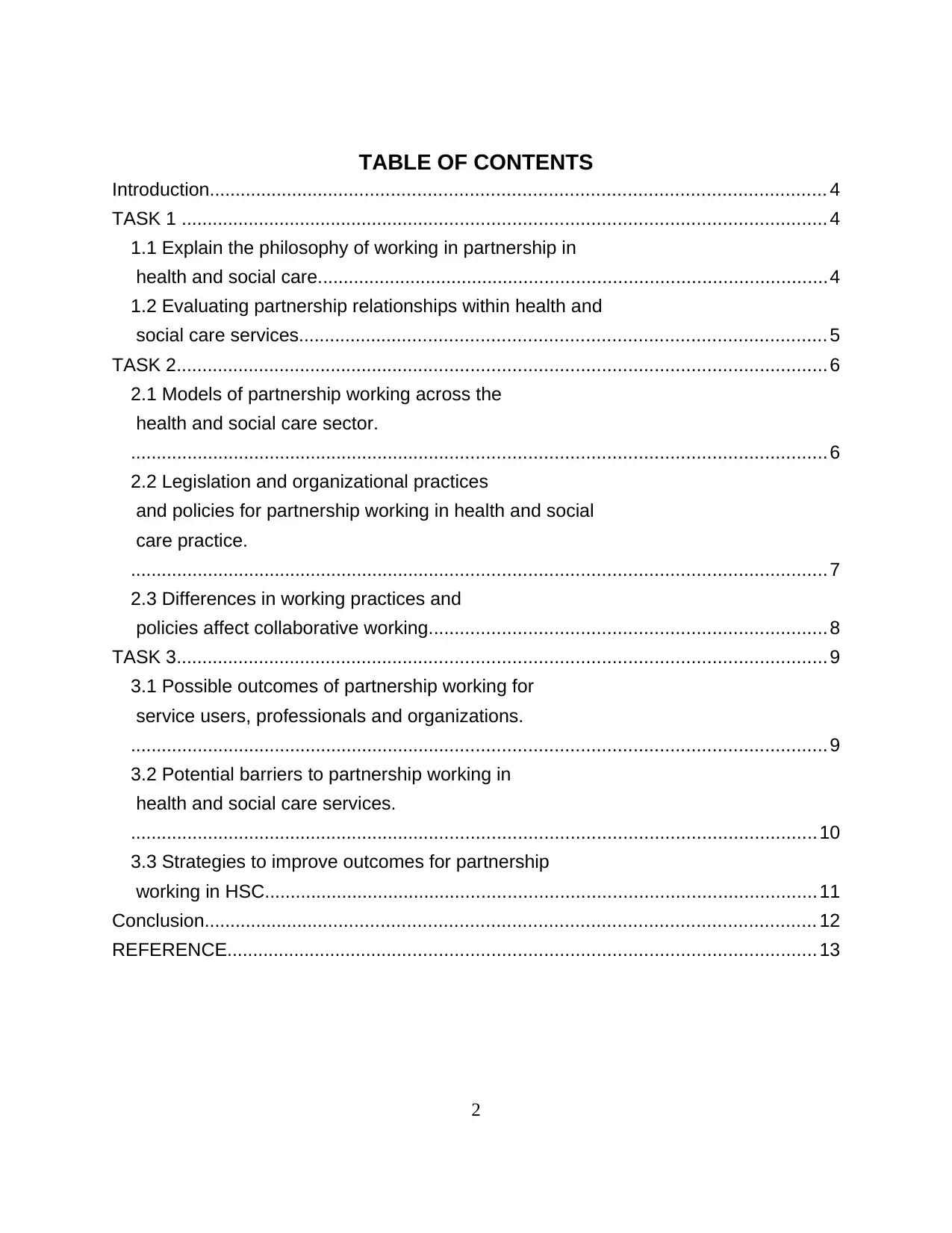
TABLE OF CONTENTS
Introduction...................................................................................................................... 4
TASK 1 ............................................................................................................................ 4
1.1 Explain the philosophy of working in partnership in
health and social care..................................................................................................4
1.2 Evaluating partnership relationships within health and
social care services..................................................................................................... 5
TASK 2.............................................................................................................................6
2.1 Models of partnership working across the
health and social care sector.
......................................................................................................................................6
2.2 Legislation and organizational practices
and policies for partnership working in health and social
care practice.
......................................................................................................................................7
2.3 Differences in working practices and
policies affect collaborative working............................................................................8
TASK 3.............................................................................................................................9
3.1 Possible outcomes of partnership working for
service users, professionals and organizations.
......................................................................................................................................9
3.2 Potential barriers to partnership working in
health and social care services.
....................................................................................................................................10
3.3 Strategies to improve outcomes for partnership
working in HSC..........................................................................................................11
Conclusion..................................................................................................................... 12
REFERENCE................................................................................................................. 13
2
Introduction...................................................................................................................... 4
TASK 1 ............................................................................................................................ 4
1.1 Explain the philosophy of working in partnership in
health and social care..................................................................................................4
1.2 Evaluating partnership relationships within health and
social care services..................................................................................................... 5
TASK 2.............................................................................................................................6
2.1 Models of partnership working across the
health and social care sector.
......................................................................................................................................6
2.2 Legislation and organizational practices
and policies for partnership working in health and social
care practice.
......................................................................................................................................7
2.3 Differences in working practices and
policies affect collaborative working............................................................................8
TASK 3.............................................................................................................................9
3.1 Possible outcomes of partnership working for
service users, professionals and organizations.
......................................................................................................................................9
3.2 Potential barriers to partnership working in
health and social care services.
....................................................................................................................................10
3.3 Strategies to improve outcomes for partnership
working in HSC..........................................................................................................11
Conclusion..................................................................................................................... 12
REFERENCE................................................................................................................. 13
2
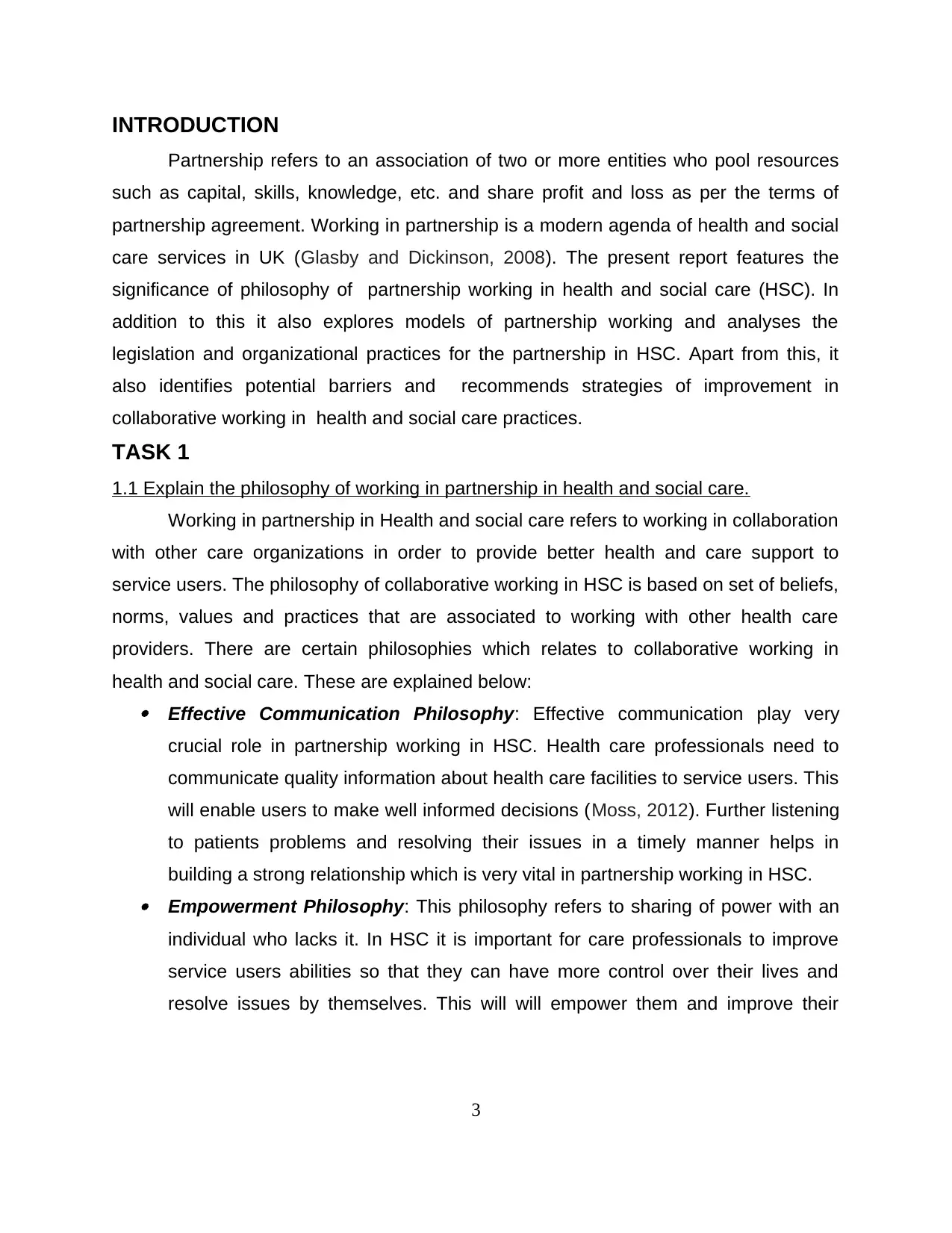
INTRODUCTION
Partnership refers to an association of two or more entities who pool resources
such as capital, skills, knowledge, etc. and share profit and loss as per the terms of
partnership agreement. Working in partnership is a modern agenda of health and social
care services in UK (Glasby and Dickinson, 2008). The present report features the
significance of philosophy of partnership working in health and social care (HSC). In
addition to this it also explores models of partnership working and analyses the
legislation and organizational practices for the partnership in HSC. Apart from this, it
also identifies potential barriers and recommends strategies of improvement in
collaborative working in health and social care practices.
TASK 1
1.1 Explain the philosophy of working in partnership in health and social care.
Working in partnership in Health and social care refers to working in collaboration
with other care organizations in order to provide better health and care support to
service users. The philosophy of collaborative working in HSC is based on set of beliefs,
norms, values and practices that are associated to working with other health care
providers. There are certain philosophies which relates to collaborative working in
health and social care. These are explained below: Effective Communication Philosophy: Effective communication play very
crucial role in partnership working in HSC. Health care professionals need to
communicate quality information about health care facilities to service users. This
will enable users to make well informed decisions (Moss, 2012). Further listening
to patients problems and resolving their issues in a timely manner helps in
building a strong relationship which is very vital in partnership working in HSC. Empowerment Philosophy: This philosophy refers to sharing of power with an
individual who lacks it. In HSC it is important for care professionals to improve
service users abilities so that they can have more control over their lives and
resolve issues by themselves. This will will empower them and improve their
3
Partnership refers to an association of two or more entities who pool resources
such as capital, skills, knowledge, etc. and share profit and loss as per the terms of
partnership agreement. Working in partnership is a modern agenda of health and social
care services in UK (Glasby and Dickinson, 2008). The present report features the
significance of philosophy of partnership working in health and social care (HSC). In
addition to this it also explores models of partnership working and analyses the
legislation and organizational practices for the partnership in HSC. Apart from this, it
also identifies potential barriers and recommends strategies of improvement in
collaborative working in health and social care practices.
TASK 1
1.1 Explain the philosophy of working in partnership in health and social care.
Working in partnership in Health and social care refers to working in collaboration
with other care organizations in order to provide better health and care support to
service users. The philosophy of collaborative working in HSC is based on set of beliefs,
norms, values and practices that are associated to working with other health care
providers. There are certain philosophies which relates to collaborative working in
health and social care. These are explained below: Effective Communication Philosophy: Effective communication play very
crucial role in partnership working in HSC. Health care professionals need to
communicate quality information about health care facilities to service users. This
will enable users to make well informed decisions (Moss, 2012). Further listening
to patients problems and resolving their issues in a timely manner helps in
building a strong relationship which is very vital in partnership working in HSC. Empowerment Philosophy: This philosophy refers to sharing of power with an
individual who lacks it. In HSC it is important for care professionals to improve
service users abilities so that they can have more control over their lives and
resolve issues by themselves. This will will empower them and improve their
3
⊘ This is a preview!⊘
Do you want full access?
Subscribe today to unlock all pages.

Trusted by 1+ million students worldwide
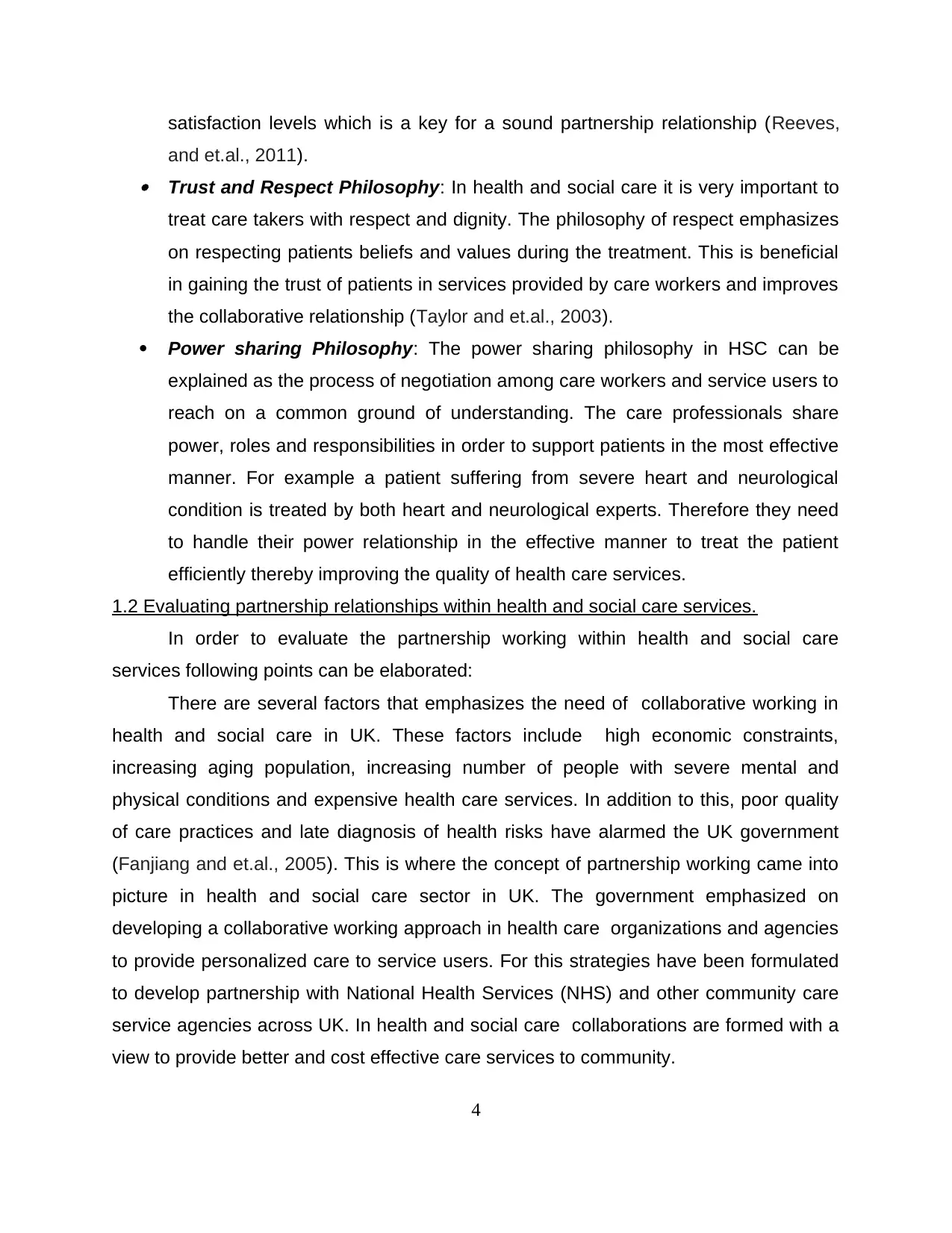
satisfaction levels which is a key for a sound partnership relationship (Reeves,
and et.al., 2011). Trust and Respect Philosophy: In health and social care it is very important to
treat care takers with respect and dignity. The philosophy of respect emphasizes
on respecting patients beliefs and values during the treatment. This is beneficial
in gaining the trust of patients in services provided by care workers and improves
the collaborative relationship (Taylor and et.al., 2003).
Power sharing Philosophy: The power sharing philosophy in HSC can be
explained as the process of negotiation among care workers and service users to
reach on a common ground of understanding. The care professionals share
power, roles and responsibilities in order to support patients in the most effective
manner. For example a patient suffering from severe heart and neurological
condition is treated by both heart and neurological experts. Therefore they need
to handle their power relationship in the effective manner to treat the patient
efficiently thereby improving the quality of health care services.
1.2 Evaluating partnership relationships within health and social care services.
In order to evaluate the partnership working within health and social care
services following points can be elaborated:
There are several factors that emphasizes the need of collaborative working in
health and social care in UK. These factors include high economic constraints,
increasing aging population, increasing number of people with severe mental and
physical conditions and expensive health care services. In addition to this, poor quality
of care practices and late diagnosis of health risks have alarmed the UK government
(Fanjiang and et.al., 2005). This is where the concept of partnership working came into
picture in health and social care sector in UK. The government emphasized on
developing a collaborative working approach in health care organizations and agencies
to provide personalized care to service users. For this strategies have been formulated
to develop partnership with National Health Services (NHS) and other community care
service agencies across UK. In health and social care collaborations are formed with a
view to provide better and cost effective care services to community.
4
and et.al., 2011). Trust and Respect Philosophy: In health and social care it is very important to
treat care takers with respect and dignity. The philosophy of respect emphasizes
on respecting patients beliefs and values during the treatment. This is beneficial
in gaining the trust of patients in services provided by care workers and improves
the collaborative relationship (Taylor and et.al., 2003).
Power sharing Philosophy: The power sharing philosophy in HSC can be
explained as the process of negotiation among care workers and service users to
reach on a common ground of understanding. The care professionals share
power, roles and responsibilities in order to support patients in the most effective
manner. For example a patient suffering from severe heart and neurological
condition is treated by both heart and neurological experts. Therefore they need
to handle their power relationship in the effective manner to treat the patient
efficiently thereby improving the quality of health care services.
1.2 Evaluating partnership relationships within health and social care services.
In order to evaluate the partnership working within health and social care
services following points can be elaborated:
There are several factors that emphasizes the need of collaborative working in
health and social care in UK. These factors include high economic constraints,
increasing aging population, increasing number of people with severe mental and
physical conditions and expensive health care services. In addition to this, poor quality
of care practices and late diagnosis of health risks have alarmed the UK government
(Fanjiang and et.al., 2005). This is where the concept of partnership working came into
picture in health and social care sector in UK. The government emphasized on
developing a collaborative working approach in health care organizations and agencies
to provide personalized care to service users. For this strategies have been formulated
to develop partnership with National Health Services (NHS) and other community care
service agencies across UK. In health and social care collaborations are formed with a
view to provide better and cost effective care services to community.
4
Paraphrase This Document
Need a fresh take? Get an instant paraphrase of this document with our AI Paraphraser
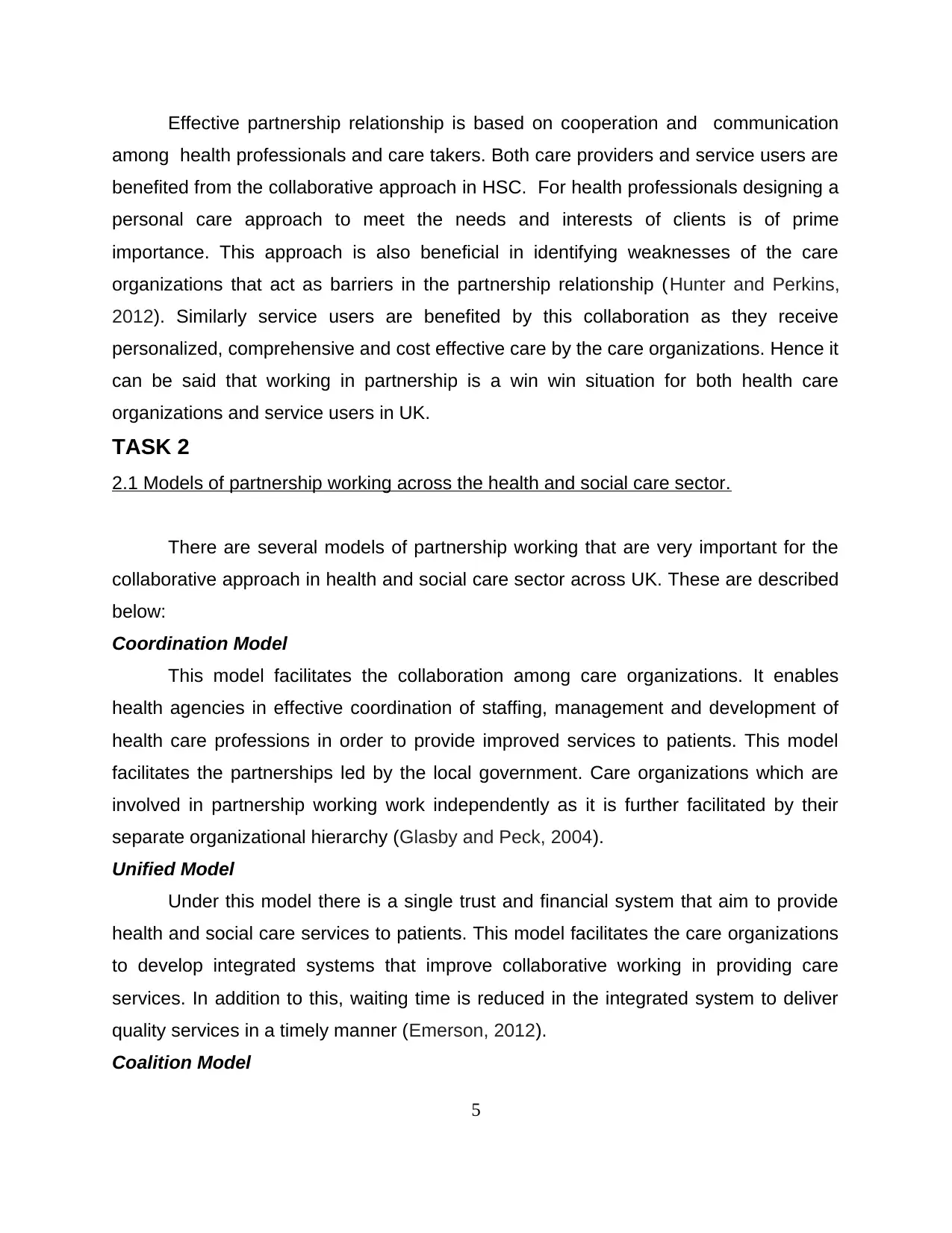
Effective partnership relationship is based on cooperation and communication
among health professionals and care takers. Both care providers and service users are
benefited from the collaborative approach in HSC. For health professionals designing a
personal care approach to meet the needs and interests of clients is of prime
importance. This approach is also beneficial in identifying weaknesses of the care
organizations that act as barriers in the partnership relationship (Hunter and Perkins,
2012). Similarly service users are benefited by this collaboration as they receive
personalized, comprehensive and cost effective care by the care organizations. Hence it
can be said that working in partnership is a win win situation for both health care
organizations and service users in UK.
TASK 2
2.1 Models of partnership working across the health and social care sector.
There are several models of partnership working that are very important for the
collaborative approach in health and social care sector across UK. These are described
below:
Coordination Model
This model facilitates the collaboration among care organizations. It enables
health agencies in effective coordination of staffing, management and development of
health care professions in order to provide improved services to patients. This model
facilitates the partnerships led by the local government. Care organizations which are
involved in partnership working work independently as it is further facilitated by their
separate organizational hierarchy (Glasby and Peck, 2004).
Unified Model
Under this model there is a single trust and financial system that aim to provide
health and social care services to patients. This model facilitates the care organizations
to develop integrated systems that improve collaborative working in providing care
services. In addition to this, waiting time is reduced in the integrated system to deliver
quality services in a timely manner (Emerson, 2012).
Coalition Model
5
among health professionals and care takers. Both care providers and service users are
benefited from the collaborative approach in HSC. For health professionals designing a
personal care approach to meet the needs and interests of clients is of prime
importance. This approach is also beneficial in identifying weaknesses of the care
organizations that act as barriers in the partnership relationship (Hunter and Perkins,
2012). Similarly service users are benefited by this collaboration as they receive
personalized, comprehensive and cost effective care by the care organizations. Hence it
can be said that working in partnership is a win win situation for both health care
organizations and service users in UK.
TASK 2
2.1 Models of partnership working across the health and social care sector.
There are several models of partnership working that are very important for the
collaborative approach in health and social care sector across UK. These are described
below:
Coordination Model
This model facilitates the collaboration among care organizations. It enables
health agencies in effective coordination of staffing, management and development of
health care professions in order to provide improved services to patients. This model
facilitates the partnerships led by the local government. Care organizations which are
involved in partnership working work independently as it is further facilitated by their
separate organizational hierarchy (Glasby and Peck, 2004).
Unified Model
Under this model there is a single trust and financial system that aim to provide
health and social care services to patients. This model facilitates the care organizations
to develop integrated systems that improve collaborative working in providing care
services. In addition to this, waiting time is reduced in the integrated system to deliver
quality services in a timely manner (Emerson, 2012).
Coalition Model
5
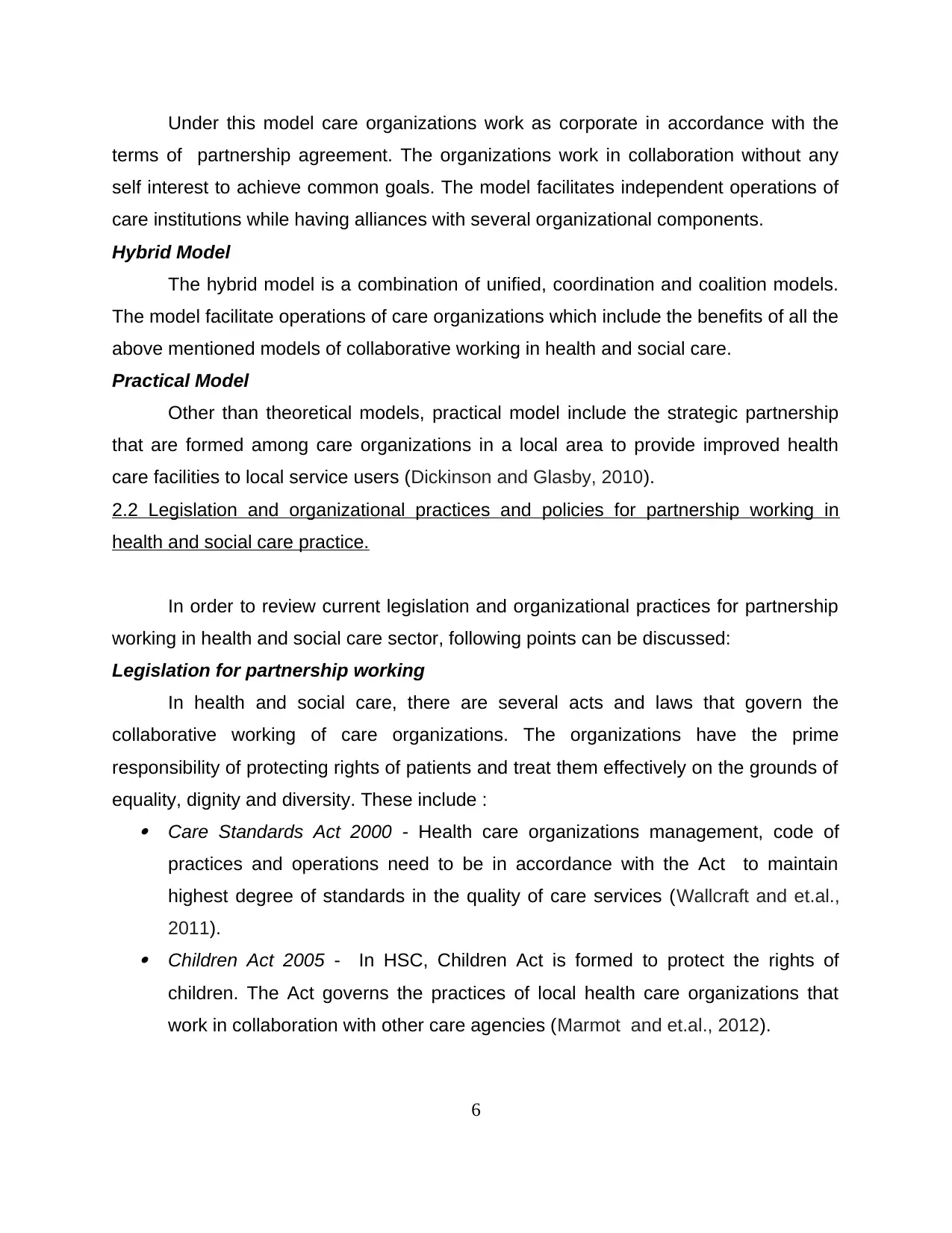
Under this model care organizations work as corporate in accordance with the
terms of partnership agreement. The organizations work in collaboration without any
self interest to achieve common goals. The model facilitates independent operations of
care institutions while having alliances with several organizational components.
Hybrid Model
The hybrid model is a combination of unified, coordination and coalition models.
The model facilitate operations of care organizations which include the benefits of all the
above mentioned models of collaborative working in health and social care.
Practical Model
Other than theoretical models, practical model include the strategic partnership
that are formed among care organizations in a local area to provide improved health
care facilities to local service users (Dickinson and Glasby, 2010).
2.2 Legislation and organizational practices and policies for partnership working in
health and social care practice.
In order to review current legislation and organizational practices for partnership
working in health and social care sector, following points can be discussed:
Legislation for partnership working
In health and social care, there are several acts and laws that govern the
collaborative working of care organizations. The organizations have the prime
responsibility of protecting rights of patients and treat them effectively on the grounds of
equality, dignity and diversity. These include : Care Standards Act 2000 - Health care organizations management, code of
practices and operations need to be in accordance with the Act to maintain
highest degree of standards in the quality of care services (Wallcraft and et.al.,
2011). Children Act 2005 - In HSC, Children Act is formed to protect the rights of
children. The Act governs the practices of local health care organizations that
work in collaboration with other care agencies (Marmot and et.al., 2012).
6
terms of partnership agreement. The organizations work in collaboration without any
self interest to achieve common goals. The model facilitates independent operations of
care institutions while having alliances with several organizational components.
Hybrid Model
The hybrid model is a combination of unified, coordination and coalition models.
The model facilitate operations of care organizations which include the benefits of all the
above mentioned models of collaborative working in health and social care.
Practical Model
Other than theoretical models, practical model include the strategic partnership
that are formed among care organizations in a local area to provide improved health
care facilities to local service users (Dickinson and Glasby, 2010).
2.2 Legislation and organizational practices and policies for partnership working in
health and social care practice.
In order to review current legislation and organizational practices for partnership
working in health and social care sector, following points can be discussed:
Legislation for partnership working
In health and social care, there are several acts and laws that govern the
collaborative working of care organizations. The organizations have the prime
responsibility of protecting rights of patients and treat them effectively on the grounds of
equality, dignity and diversity. These include : Care Standards Act 2000 - Health care organizations management, code of
practices and operations need to be in accordance with the Act to maintain
highest degree of standards in the quality of care services (Wallcraft and et.al.,
2011). Children Act 2005 - In HSC, Children Act is formed to protect the rights of
children. The Act governs the practices of local health care organizations that
work in collaboration with other care agencies (Marmot and et.al., 2012).
6
⊘ This is a preview!⊘
Do you want full access?
Subscribe today to unlock all pages.

Trusted by 1+ million students worldwide
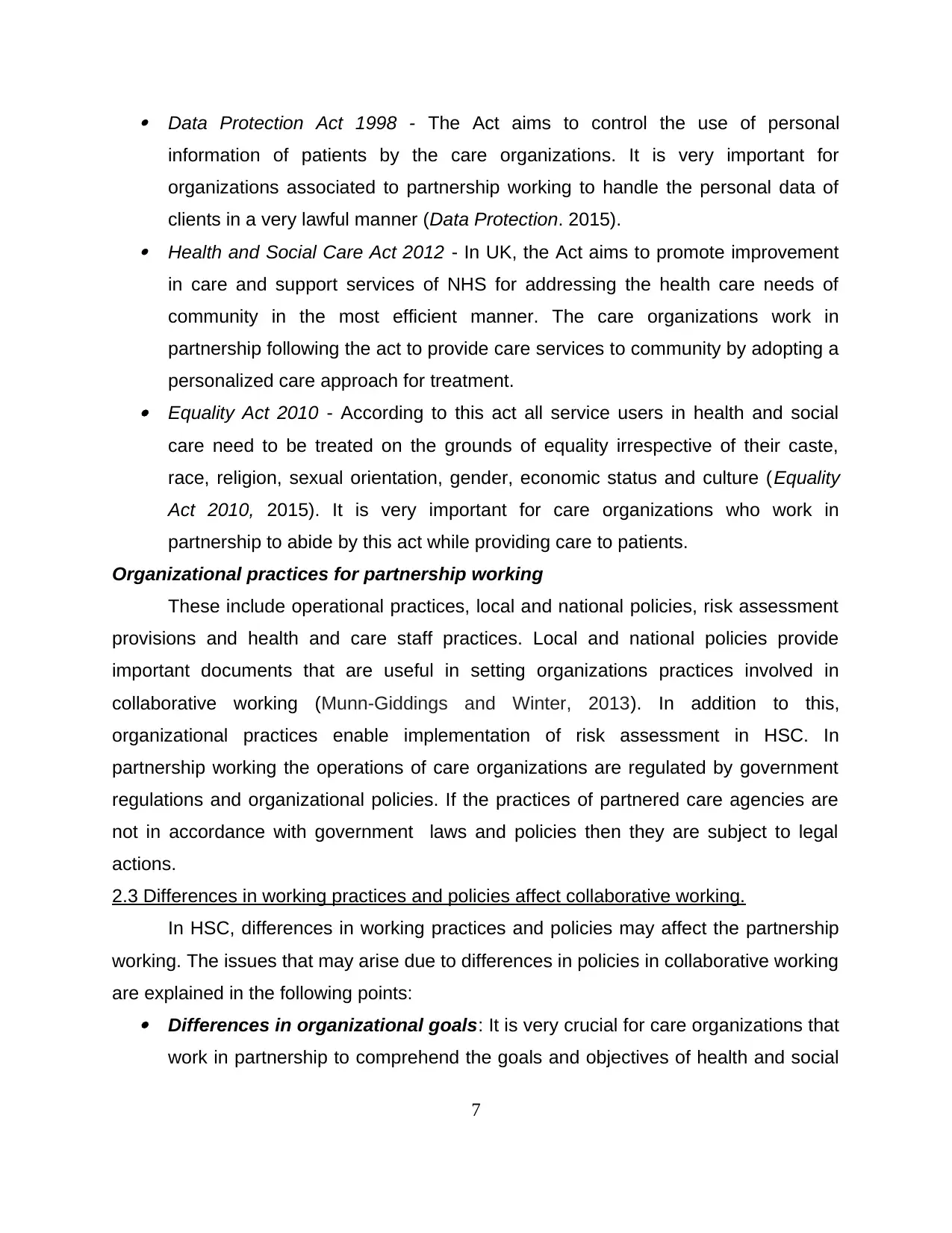
Data Protection Act 1998 - The Act aims to control the use of personal
information of patients by the care organizations. It is very important for
organizations associated to partnership working to handle the personal data of
clients in a very lawful manner (Data Protection. 2015). Health and Social Care Act 2012 - In UK, the Act aims to promote improvement
in care and support services of NHS for addressing the health care needs of
community in the most efficient manner. The care organizations work in
partnership following the act to provide care services to community by adopting a
personalized care approach for treatment. Equality Act 2010 - According to this act all service users in health and social
care need to be treated on the grounds of equality irrespective of their caste,
race, religion, sexual orientation, gender, economic status and culture (Equality
Act 2010, 2015). It is very important for care organizations who work in
partnership to abide by this act while providing care to patients.
Organizational practices for partnership working
These include operational practices, local and national policies, risk assessment
provisions and health and care staff practices. Local and national policies provide
important documents that are useful in setting organizations practices involved in
collaborative working (Munn-Giddings and Winter, 2013). In addition to this,
organizational practices enable implementation of risk assessment in HSC. In
partnership working the operations of care organizations are regulated by government
regulations and organizational policies. If the practices of partnered care agencies are
not in accordance with government laws and policies then they are subject to legal
actions.
2.3 Differences in working practices and policies affect collaborative working.
In HSC, differences in working practices and policies may affect the partnership
working. The issues that may arise due to differences in policies in collaborative working
are explained in the following points: Differences in organizational goals: It is very crucial for care organizations that
work in partnership to comprehend the goals and objectives of health and social
7
information of patients by the care organizations. It is very important for
organizations associated to partnership working to handle the personal data of
clients in a very lawful manner (Data Protection. 2015). Health and Social Care Act 2012 - In UK, the Act aims to promote improvement
in care and support services of NHS for addressing the health care needs of
community in the most efficient manner. The care organizations work in
partnership following the act to provide care services to community by adopting a
personalized care approach for treatment. Equality Act 2010 - According to this act all service users in health and social
care need to be treated on the grounds of equality irrespective of their caste,
race, religion, sexual orientation, gender, economic status and culture (Equality
Act 2010, 2015). It is very important for care organizations who work in
partnership to abide by this act while providing care to patients.
Organizational practices for partnership working
These include operational practices, local and national policies, risk assessment
provisions and health and care staff practices. Local and national policies provide
important documents that are useful in setting organizations practices involved in
collaborative working (Munn-Giddings and Winter, 2013). In addition to this,
organizational practices enable implementation of risk assessment in HSC. In
partnership working the operations of care organizations are regulated by government
regulations and organizational policies. If the practices of partnered care agencies are
not in accordance with government laws and policies then they are subject to legal
actions.
2.3 Differences in working practices and policies affect collaborative working.
In HSC, differences in working practices and policies may affect the partnership
working. The issues that may arise due to differences in policies in collaborative working
are explained in the following points: Differences in organizational goals: It is very crucial for care organizations that
work in partnership to comprehend the goals and objectives of health and social
7
Paraphrase This Document
Need a fresh take? Get an instant paraphrase of this document with our AI Paraphraser
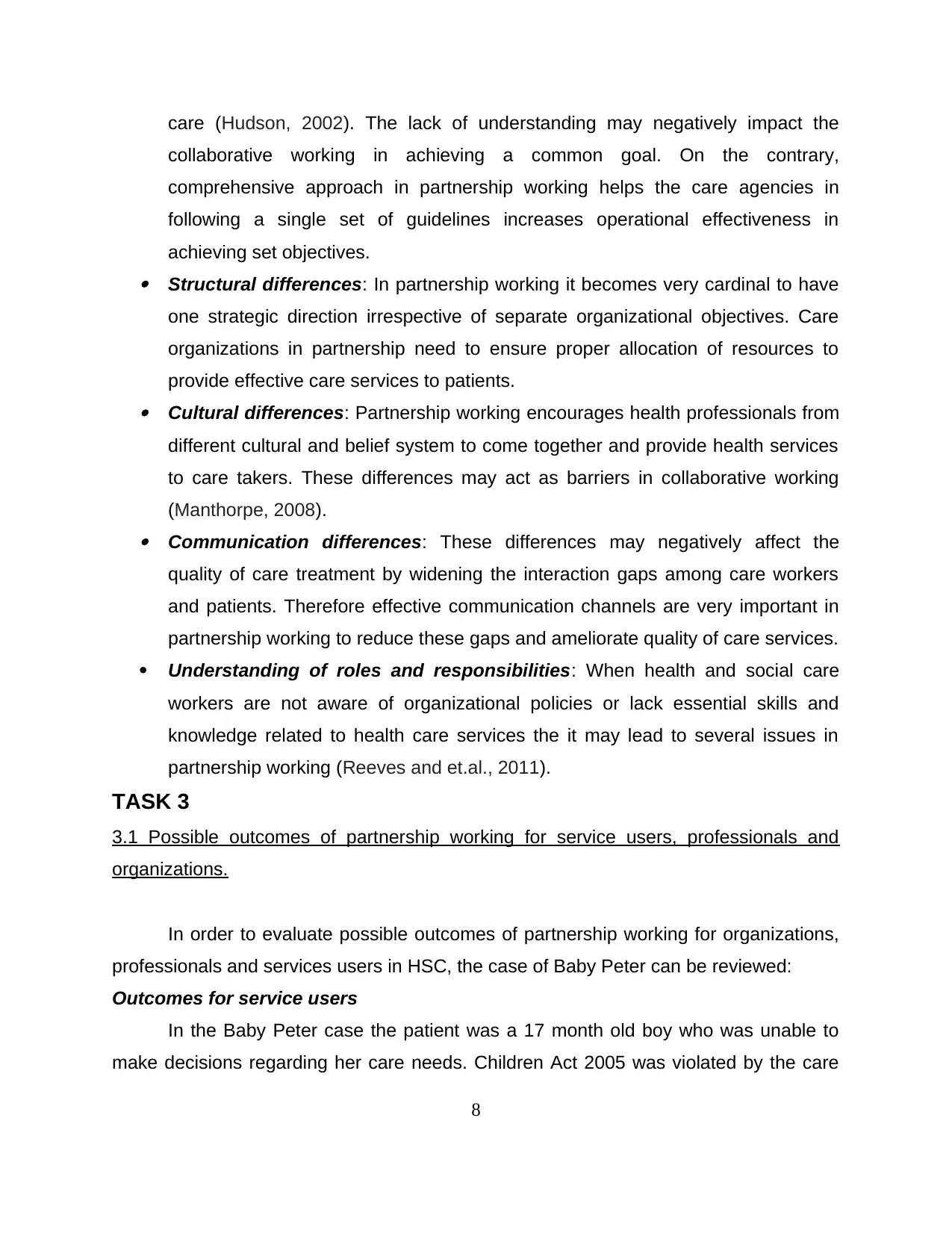
care (Hudson, 2002). The lack of understanding may negatively impact the
collaborative working in achieving a common goal. On the contrary,
comprehensive approach in partnership working helps the care agencies in
following a single set of guidelines increases operational effectiveness in
achieving set objectives. Structural differences: In partnership working it becomes very cardinal to have
one strategic direction irrespective of separate organizational objectives. Care
organizations in partnership need to ensure proper allocation of resources to
provide effective care services to patients. Cultural differences: Partnership working encourages health professionals from
different cultural and belief system to come together and provide health services
to care takers. These differences may act as barriers in collaborative working
(Manthorpe, 2008). Communication differences: These differences may negatively affect the
quality of care treatment by widening the interaction gaps among care workers
and patients. Therefore effective communication channels are very important in
partnership working to reduce these gaps and ameliorate quality of care services.
Understanding of roles and responsibilities: When health and social care
workers are not aware of organizational policies or lack essential skills and
knowledge related to health care services the it may lead to several issues in
partnership working (Reeves and et.al., 2011).
TASK 3
3.1 Possible outcomes of partnership working for service users, professionals and
organizations.
In order to evaluate possible outcomes of partnership working for organizations,
professionals and services users in HSC, the case of Baby Peter can be reviewed:
Outcomes for service users
In the Baby Peter case the patient was a 17 month old boy who was unable to
make decisions regarding her care needs. Children Act 2005 was violated by the care
8
collaborative working in achieving a common goal. On the contrary,
comprehensive approach in partnership working helps the care agencies in
following a single set of guidelines increases operational effectiveness in
achieving set objectives. Structural differences: In partnership working it becomes very cardinal to have
one strategic direction irrespective of separate organizational objectives. Care
organizations in partnership need to ensure proper allocation of resources to
provide effective care services to patients. Cultural differences: Partnership working encourages health professionals from
different cultural and belief system to come together and provide health services
to care takers. These differences may act as barriers in collaborative working
(Manthorpe, 2008). Communication differences: These differences may negatively affect the
quality of care treatment by widening the interaction gaps among care workers
and patients. Therefore effective communication channels are very important in
partnership working to reduce these gaps and ameliorate quality of care services.
Understanding of roles and responsibilities: When health and social care
workers are not aware of organizational policies or lack essential skills and
knowledge related to health care services the it may lead to several issues in
partnership working (Reeves and et.al., 2011).
TASK 3
3.1 Possible outcomes of partnership working for service users, professionals and
organizations.
In order to evaluate possible outcomes of partnership working for organizations,
professionals and services users in HSC, the case of Baby Peter can be reviewed:
Outcomes for service users
In the Baby Peter case the patient was a 17 month old boy who was unable to
make decisions regarding her care needs. Children Act 2005 was violated by the care
8
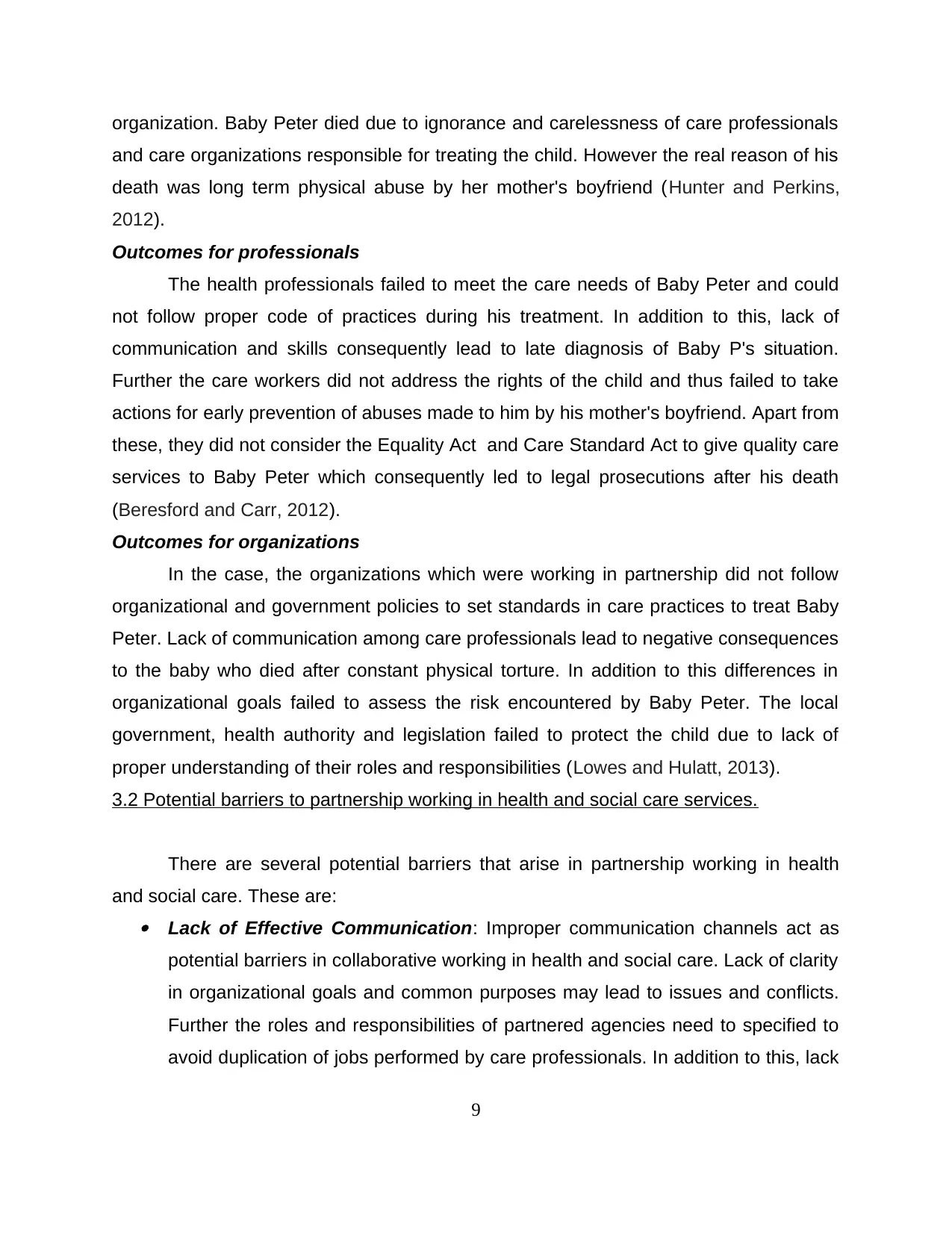
organization. Baby Peter died due to ignorance and carelessness of care professionals
and care organizations responsible for treating the child. However the real reason of his
death was long term physical abuse by her mother's boyfriend (Hunter and Perkins,
2012).
Outcomes for professionals
The health professionals failed to meet the care needs of Baby Peter and could
not follow proper code of practices during his treatment. In addition to this, lack of
communication and skills consequently lead to late diagnosis of Baby P's situation.
Further the care workers did not address the rights of the child and thus failed to take
actions for early prevention of abuses made to him by his mother's boyfriend. Apart from
these, they did not consider the Equality Act and Care Standard Act to give quality care
services to Baby Peter which consequently led to legal prosecutions after his death
(Beresford and Carr, 2012).
Outcomes for organizations
In the case, the organizations which were working in partnership did not follow
organizational and government policies to set standards in care practices to treat Baby
Peter. Lack of communication among care professionals lead to negative consequences
to the baby who died after constant physical torture. In addition to this differences in
organizational goals failed to assess the risk encountered by Baby Peter. The local
government, health authority and legislation failed to protect the child due to lack of
proper understanding of their roles and responsibilities (Lowes and Hulatt, 2013).
3.2 Potential barriers to partnership working in health and social care services.
There are several potential barriers that arise in partnership working in health
and social care. These are: Lack of Effective Communication: Improper communication channels act as
potential barriers in collaborative working in health and social care. Lack of clarity
in organizational goals and common purposes may lead to issues and conflicts.
Further the roles and responsibilities of partnered agencies need to specified to
avoid duplication of jobs performed by care professionals. In addition to this, lack
9
and care organizations responsible for treating the child. However the real reason of his
death was long term physical abuse by her mother's boyfriend (Hunter and Perkins,
2012).
Outcomes for professionals
The health professionals failed to meet the care needs of Baby Peter and could
not follow proper code of practices during his treatment. In addition to this, lack of
communication and skills consequently lead to late diagnosis of Baby P's situation.
Further the care workers did not address the rights of the child and thus failed to take
actions for early prevention of abuses made to him by his mother's boyfriend. Apart from
these, they did not consider the Equality Act and Care Standard Act to give quality care
services to Baby Peter which consequently led to legal prosecutions after his death
(Beresford and Carr, 2012).
Outcomes for organizations
In the case, the organizations which were working in partnership did not follow
organizational and government policies to set standards in care practices to treat Baby
Peter. Lack of communication among care professionals lead to negative consequences
to the baby who died after constant physical torture. In addition to this differences in
organizational goals failed to assess the risk encountered by Baby Peter. The local
government, health authority and legislation failed to protect the child due to lack of
proper understanding of their roles and responsibilities (Lowes and Hulatt, 2013).
3.2 Potential barriers to partnership working in health and social care services.
There are several potential barriers that arise in partnership working in health
and social care. These are: Lack of Effective Communication: Improper communication channels act as
potential barriers in collaborative working in health and social care. Lack of clarity
in organizational goals and common purposes may lead to issues and conflicts.
Further the roles and responsibilities of partnered agencies need to specified to
avoid duplication of jobs performed by care professionals. In addition to this, lack
9
⊘ This is a preview!⊘
Do you want full access?
Subscribe today to unlock all pages.

Trusted by 1+ million students worldwide
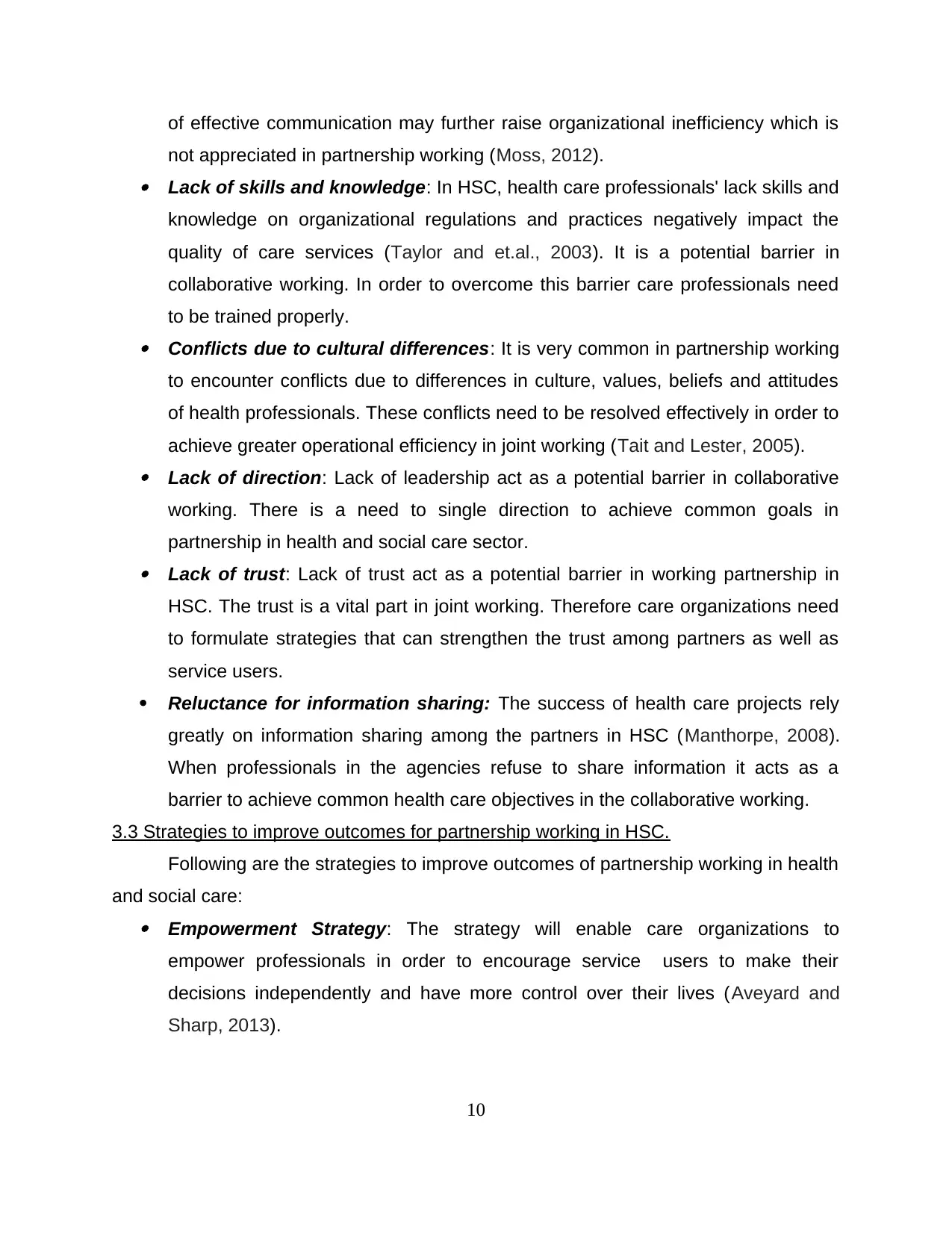
of effective communication may further raise organizational inefficiency which is
not appreciated in partnership working (Moss, 2012). Lack of skills and knowledge: In HSC, health care professionals' lack skills and
knowledge on organizational regulations and practices negatively impact the
quality of care services (Taylor and et.al., 2003). It is a potential barrier in
collaborative working. In order to overcome this barrier care professionals need
to be trained properly. Conflicts due to cultural differences: It is very common in partnership working
to encounter conflicts due to differences in culture, values, beliefs and attitudes
of health professionals. These conflicts need to be resolved effectively in order to
achieve greater operational efficiency in joint working (Tait and Lester, 2005). Lack of direction: Lack of leadership act as a potential barrier in collaborative
working. There is a need to single direction to achieve common goals in
partnership in health and social care sector. Lack of trust: Lack of trust act as a potential barrier in working partnership in
HSC. The trust is a vital part in joint working. Therefore care organizations need
to formulate strategies that can strengthen the trust among partners as well as
service users.
Reluctance for information sharing: The success of health care projects rely
greatly on information sharing among the partners in HSC (Manthorpe, 2008).
When professionals in the agencies refuse to share information it acts as a
barrier to achieve common health care objectives in the collaborative working.
3.3 Strategies to improve outcomes for partnership working in HSC.
Following are the strategies to improve outcomes of partnership working in health
and social care: Empowerment Strategy: The strategy will enable care organizations to
empower professionals in order to encourage service users to make their
decisions independently and have more control over their lives (Aveyard and
Sharp, 2013).
10
not appreciated in partnership working (Moss, 2012). Lack of skills and knowledge: In HSC, health care professionals' lack skills and
knowledge on organizational regulations and practices negatively impact the
quality of care services (Taylor and et.al., 2003). It is a potential barrier in
collaborative working. In order to overcome this barrier care professionals need
to be trained properly. Conflicts due to cultural differences: It is very common in partnership working
to encounter conflicts due to differences in culture, values, beliefs and attitudes
of health professionals. These conflicts need to be resolved effectively in order to
achieve greater operational efficiency in joint working (Tait and Lester, 2005). Lack of direction: Lack of leadership act as a potential barrier in collaborative
working. There is a need to single direction to achieve common goals in
partnership in health and social care sector. Lack of trust: Lack of trust act as a potential barrier in working partnership in
HSC. The trust is a vital part in joint working. Therefore care organizations need
to formulate strategies that can strengthen the trust among partners as well as
service users.
Reluctance for information sharing: The success of health care projects rely
greatly on information sharing among the partners in HSC (Manthorpe, 2008).
When professionals in the agencies refuse to share information it acts as a
barrier to achieve common health care objectives in the collaborative working.
3.3 Strategies to improve outcomes for partnership working in HSC.
Following are the strategies to improve outcomes of partnership working in health
and social care: Empowerment Strategy: The strategy will enable care organizations to
empower professionals in order to encourage service users to make their
decisions independently and have more control over their lives (Aveyard and
Sharp, 2013).
10
Paraphrase This Document
Need a fresh take? Get an instant paraphrase of this document with our AI Paraphraser
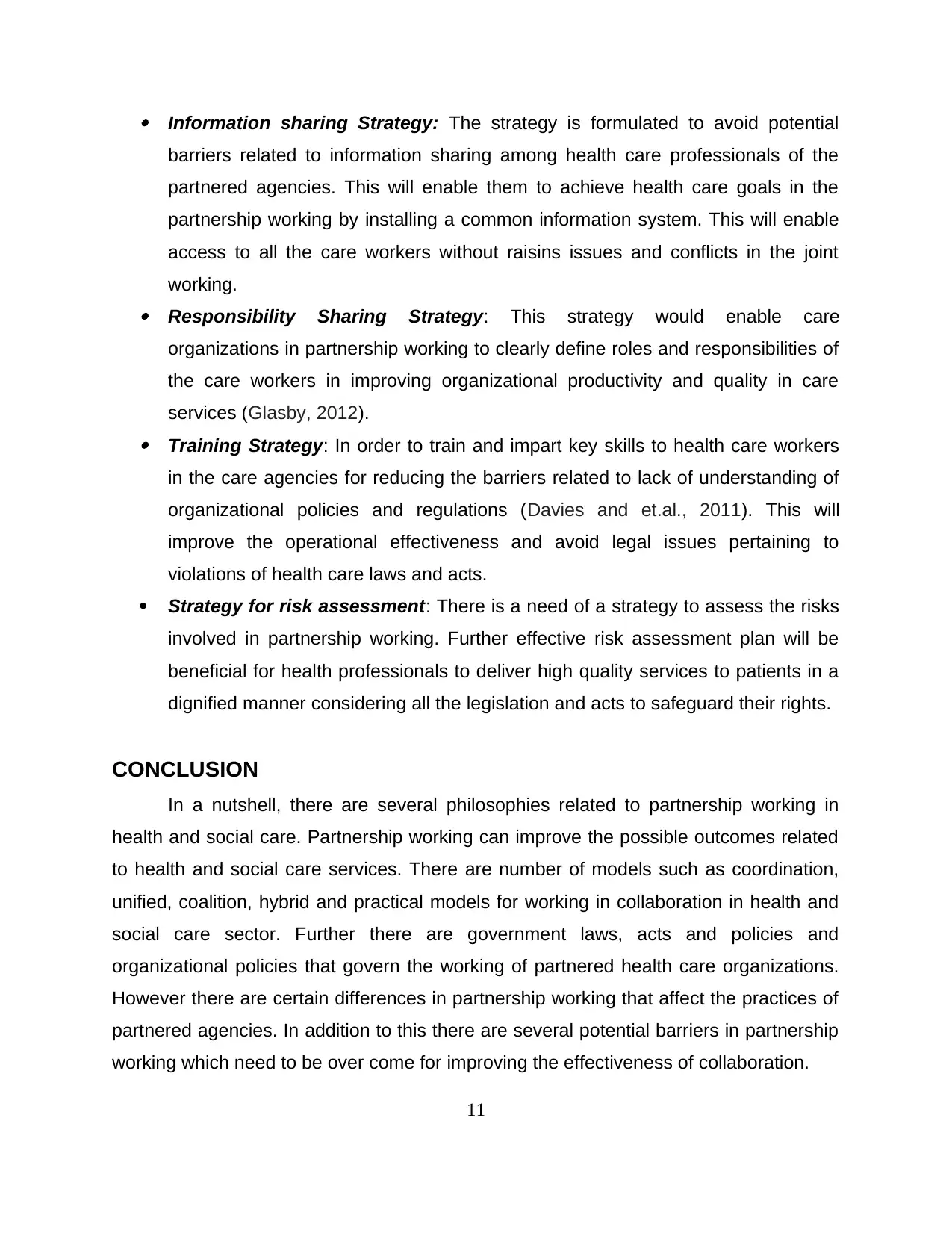
Information sharing Strategy: The strategy is formulated to avoid potential
barriers related to information sharing among health care professionals of the
partnered agencies. This will enable them to achieve health care goals in the
partnership working by installing a common information system. This will enable
access to all the care workers without raisins issues and conflicts in the joint
working. Responsibility Sharing Strategy: This strategy would enable care
organizations in partnership working to clearly define roles and responsibilities of
the care workers in improving organizational productivity and quality in care
services (Glasby, 2012). Training Strategy: In order to train and impart key skills to health care workers
in the care agencies for reducing the barriers related to lack of understanding of
organizational policies and regulations (Davies and et.al., 2011). This will
improve the operational effectiveness and avoid legal issues pertaining to
violations of health care laws and acts.
Strategy for risk assessment: There is a need of a strategy to assess the risks
involved in partnership working. Further effective risk assessment plan will be
beneficial for health professionals to deliver high quality services to patients in a
dignified manner considering all the legislation and acts to safeguard their rights.
CONCLUSION
In a nutshell, there are several philosophies related to partnership working in
health and social care. Partnership working can improve the possible outcomes related
to health and social care services. There are number of models such as coordination,
unified, coalition, hybrid and practical models for working in collaboration in health and
social care sector. Further there are government laws, acts and policies and
organizational policies that govern the working of partnered health care organizations.
However there are certain differences in partnership working that affect the practices of
partnered agencies. In addition to this there are several potential barriers in partnership
working which need to be over come for improving the effectiveness of collaboration.
11
barriers related to information sharing among health care professionals of the
partnered agencies. This will enable them to achieve health care goals in the
partnership working by installing a common information system. This will enable
access to all the care workers without raisins issues and conflicts in the joint
working. Responsibility Sharing Strategy: This strategy would enable care
organizations in partnership working to clearly define roles and responsibilities of
the care workers in improving organizational productivity and quality in care
services (Glasby, 2012). Training Strategy: In order to train and impart key skills to health care workers
in the care agencies for reducing the barriers related to lack of understanding of
organizational policies and regulations (Davies and et.al., 2011). This will
improve the operational effectiveness and avoid legal issues pertaining to
violations of health care laws and acts.
Strategy for risk assessment: There is a need of a strategy to assess the risks
involved in partnership working. Further effective risk assessment plan will be
beneficial for health professionals to deliver high quality services to patients in a
dignified manner considering all the legislation and acts to safeguard their rights.
CONCLUSION
In a nutshell, there are several philosophies related to partnership working in
health and social care. Partnership working can improve the possible outcomes related
to health and social care services. There are number of models such as coordination,
unified, coalition, hybrid and practical models for working in collaboration in health and
social care sector. Further there are government laws, acts and policies and
organizational policies that govern the working of partnered health care organizations.
However there are certain differences in partnership working that affect the practices of
partnered agencies. In addition to this there are several potential barriers in partnership
working which need to be over come for improving the effectiveness of collaboration.
11

12
⊘ This is a preview!⊘
Do you want full access?
Subscribe today to unlock all pages.

Trusted by 1+ million students worldwide
1 out of 14
Related Documents
Your All-in-One AI-Powered Toolkit for Academic Success.
+13062052269
info@desklib.com
Available 24*7 on WhatsApp / Email
![[object Object]](/_next/static/media/star-bottom.7253800d.svg)
Unlock your academic potential
Copyright © 2020–2025 A2Z Services. All Rights Reserved. Developed and managed by ZUCOL.





